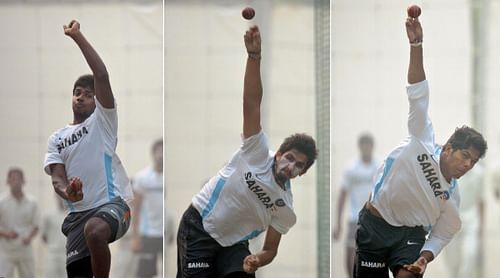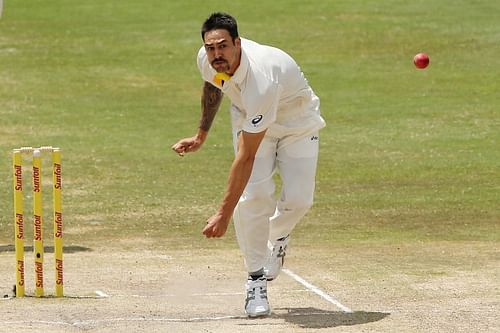
Time for Indian cricket to look beyond MS Dhoni the Test captain

A bowler who stands at 6’ 3’’, a bowler who swings the ball both ways appreciably, a bowler who is good with the older ball, a couple of bowlers who are genuinely quick and a spinner who spins the ball both ways: this is what the ‘worst’ bowling line-up in the world consists of. The variety seen in this phalanx is paralleled only by the intimidating South African bowling battery.
The most experienced member of the Indian line-up has picked up 36 wickets in Tests this year at an average of 28.86. One of those genuinely quick fast bowlers was the second highest wicket-taker in the recently concluded ODI series that was played on feather beds. That bloke who swings the ball both ways was the awardee of the ICC People’s Choice award this year.
Yes, I am talking about the Indian pace bowling attack. A bowling unit that has the variety, technicality, pace and all the other elements in the periodic table of bowling to make a formidable bowling attack. Yet they are pushed down into the chasm of gratuitous criticisms of being below par and poor, just because they have not been utilised in a manner that they should have been.
Bowlers take an advantage, Dhoni concedes it back
In the last 12 months, the very same mediocre bowling line-up has given its team a position of superiority on three occasions. In December last year, the Indian fast bowling unit had the South African team all out for 244, giving India a first innings lead of 34. In the fourth innings of the match, the pace battery had the batting team, who were chasing a stiff 458, 4 down for 197; however, all they could manage was a draw, thanks to some supernatural, extraterrestrial defensive approach by the Indian skipper.
In February this year, the ill-fated Indian bowling once again gave India a head start in the second Test match against New Zealand in Wellington. Ishant Sharma and Mohammed Shami looted all the Kiwi wickets for just 192 runs. At the end of the second day, Indians had a whopping lead of 246. The Indian pace mill was on a roll again as they reduced New Zealand to 94 for 5. Normally, captains would have sensed an opening, capitalised on it and made sure they went home early. But his excellency Mahendra Singh Dhoni decided to take the game right down to the last day as he often does during the chases in limited overs cricket, to help the Kiwis release themselves from the firm grip of the Indians, amassing 352 runs for the 6th wicket.
The misery of the Indian fast bowlers does not end there. In the latest Test match against Australia, India once again had an opportunity to take the game by the scruff of the neck. India, after posting 408, had the Australian batting line-up reeling at 247 for 6. Dhoni’s unexplored part of the brain started functioning, again, as logics applicable to the normal world faded away.
Mainstream methodologies lost their hue, got warped out and burst like a water bubble. His mind was now filled with quixotic, inscrutable ploys. The Indian bowlers, who had been bowling proper Test match lines and lengths, were asked to welcome Mitchell Johnson with a barrage of bouncers. The skipper somehow forgot how the previous wickets were exacted as he tried a plot that was too raw and rudimentary; as a result, the Australian tail took their team to 505, which, in the end, proved to be decisive as Australia romped home with just 4 wickets to spare.
Once again, the Indian bowling was heckled as being poor; some even dared to travel the extent of asking how Dhoni could be expected to deliver with this bowling attack. Weren’t they the same bowlers who brought the elusive chance of a victory within India’s eyesight? Wasn't bowling short a tactical blunder?
As a neutral fan, I can vouch for the fact that India’s pace attack should be one of the best. The way they are squandered reminds me of a facebook meme.
The amount of resources you have doesn’t matter if you don’t have a leader who can use it properly.
Dhoni’s incompetence as captain in Test cricket
In India’s recent overseas Test series, it can be easily observed that Dhoni’s tactics have failed. Against England this year, Dhoni preferred Ravindra Jadeja over Ravichandran Ashwin for the lone spinner’s spot. It is well known that Jadeja, at Test level, is a bits and pieces player. He is neither a specialist spinner nor a specialist batsman. Persisting with him over Ashwin is one of those logics that can only be explained by Dhoni himself.
In the same series, Dhoni played a match with two spinners while the home team went with none. In conditions that are conducive to seam bowling, how could you explain playing two spinners? Why wasn’t Stuart Binny properly utilised as a bowling all-rounder?
If subcontinent teams love to use their spinners as a trump card, Dhoni the captain was the polar opposite, making Jadeja bowl an unfathomable leg stump line for a god-knows-why reason.
If employing catchers and close-in fielders and cutting down easy runs is the typical Test match approach, Dhoni stands special in a way that he deploys sweepers, sometimes as early as the first session of the match. Does he try to follow the Gandhian way when dealing with the opposition batsmen? Does he think that through non-violence he can conquer enemies?
Dhoni lacks persistence and patience. Sometimes, he acts like the fox in the ‘Fox and the Grapes’ fable: Dhoni attempts to attack, and if he fails to reap prompt results, he just says “this would not work” and just moves away.
The classical way of strangling the batsmen and forcing them to make mistakes is not Dhoni’s favorite. He, instead, loves waiting for the batsmen to make mistakes of their own. Thank god, he does not play tennis, for he will be waiting for unforced errors from the opposition. His approach is analogous to throwing the trace of a fishing rod into waters without a bait and waiting for a fish to get caught by its own fault. Captains are expected to be proactive; Dhoni, however, has his own ways.
It is reprehensible that Dhoni does not trust his own bowlers. If, as a captain, you don’t trust your own bowlers, who else will? Does he understand that building a Test team is not as easy as purchasing quality players for his franchise? Does he expect a mixture of Dale Steyn and Mitchell Johnson to fall from the sky into the Indian bowling ranks?

Australia were able to make a remarkable transformation from losing the Ashes in England 0-3 to winning it 5-0 at home because they found a coach who trusted his disciples. Sometimes, pure trust can make ordinary bowlers extraordinary. The wayward Mitchell Johnson became the fiery Johnson because captain Michael Clarke trusted him and gave him the license to attack. The field set for Johnson was not for his loose deliveries, but for the wicket taking ones.
In more than one occasion, Dhoni failed to capitalise on opportunities. Ceasing moments is an important aspect of playing Test cricket.
Another aspect of Dhoni I would like to discuss is his own performance. When captains are ready to run a lone show when their team members fail, Dhoni has been a mere spectator. Brendon McCullum, Misbah-ul-Haq, Steve Smith, Angelo Mathews and Virat Kohli have all lead their team from the front by ratcheting up their own games when made the captain. McCullum’s triple earlier this year, Mathews’ 160 against England and Kohli’s 4th innings century in Adelaide are all examples of how a true leader should show the way forward for a team that had failed. Unfortunately, Dhoni’s bat and, to an extent, his gloves don’t speak much outside home.
It is true that, in Tests, a captain should make it into the eleven on captaincy alone as Darren Sammy did for West Indies when he hauled his team to safety from the brink of a precipice. But, with failures in batting, dropped catches and tactical bloopers, how does Dhoni find a place in the Test side? I will leave Dhoni’s place in the Test side on mooted grounds.